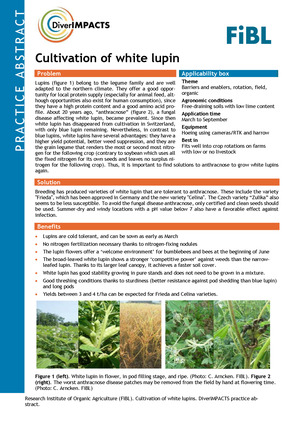Cultivation of white lupin
Authors: Christine Arncken, Hansueli Dierauer, Mathias Christe
Problem: Lupins belong to the legume family and are well adapted to the northern climate. They offer a good opportunity for local protein supply (especially for animal feed, although opportunities also exist for human consumption), since they have a high protein content and a good amino acid profile. About 20 years ago, “anthracnose”, a fungal disease affecting white lupin, became prevalent. Since then white lupin has disappeared from cultivation in Switzerland, with only blue lupin remaining. Nevertheless, in contrast to blue lupins, white lupins have several advantages: they have a higher yield potential, better weed suppression, and they are the grain legume that renders the most or second most nitrogen for the following crop (contrary to soybean which uses all the fixed nitrogen for its own seeds and leaves no surplus nitrogen for the following crop). Thus, it is important to find solutions to anthracnose to grow white lupins again.
Solution: Breeding has produced varieties of white lupin that are tolerant to anthracnose. These include the variety "Frieda", which has been approved in Germany and the new variety "Celina". The Czech variety “Zulika” also seems to be less susceptible. To avoid the fungal disease anthracnose, only certified and clean seeds should be used. Summer-dry and windy locations with a pH value below 7 also have a favorable effect against infection.
zenodo.org: Cultivation of white lupin

 Souhaitez-vous ajouter le site web à l'écran d'accueil ?
Souhaitez-vous ajouter le site web à l'écran d'accueil ?